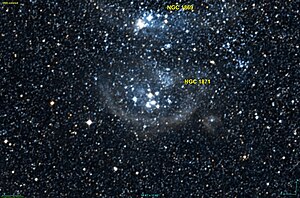THE L106

|
|
| AladinLite | |
| Constellation | Swordfish |
|
Position equinox : J2000.0 |
|
|---|---|
| Right ascension | 05 h 13 m 51.7 s |
| declination | -67 ° 27 ′ 09 ″ |
| Appearance
|
|
| Brightness (visual) | 10.1 mag |
| Brightness (B-band) | 10.2 mag |
| Angular expansion | 2 ′ |
| Physical data
|
|
| Affiliation | Large Magellanic Cloud |
| history | |
| Discovered by | James Dunlop |
| Discovery time | September 5, 1826 |
| Catalog names | |
| NGC 1871 • ESO 56-SC085 • GC 1081 • h 2800 • DEM L106 | |
DEM L106 or DEM 106 is a super bubble in the Large Magellanic Cloud . It contains N30B , a star formation region and reflection nebula (also the origin of the entry NGC 1871 in the New General Catalog ). The OB association LH 38 with Hen S22 is embedded in this H-II area . The object was discovered by James Dunlop on September 5, 1826 .
The name of the object comes from a survey by Davies, Elliott and Meaburn from the 1970s, the L stands for the Large Magellanic Cloud (L = Large ).

Image of the Hubble Space Telescope with a section from DEM L106 ; the bright star above is the supergiant Hen S22 , below is the H-II area N30B .
literature
- Chen et al .: "Hubble Space Telescope Wide Field Planetary Camera 2 Imaging of Shocks in Superbubbles"; The Astronomical Journal 119 (3), pp. 1317-1324